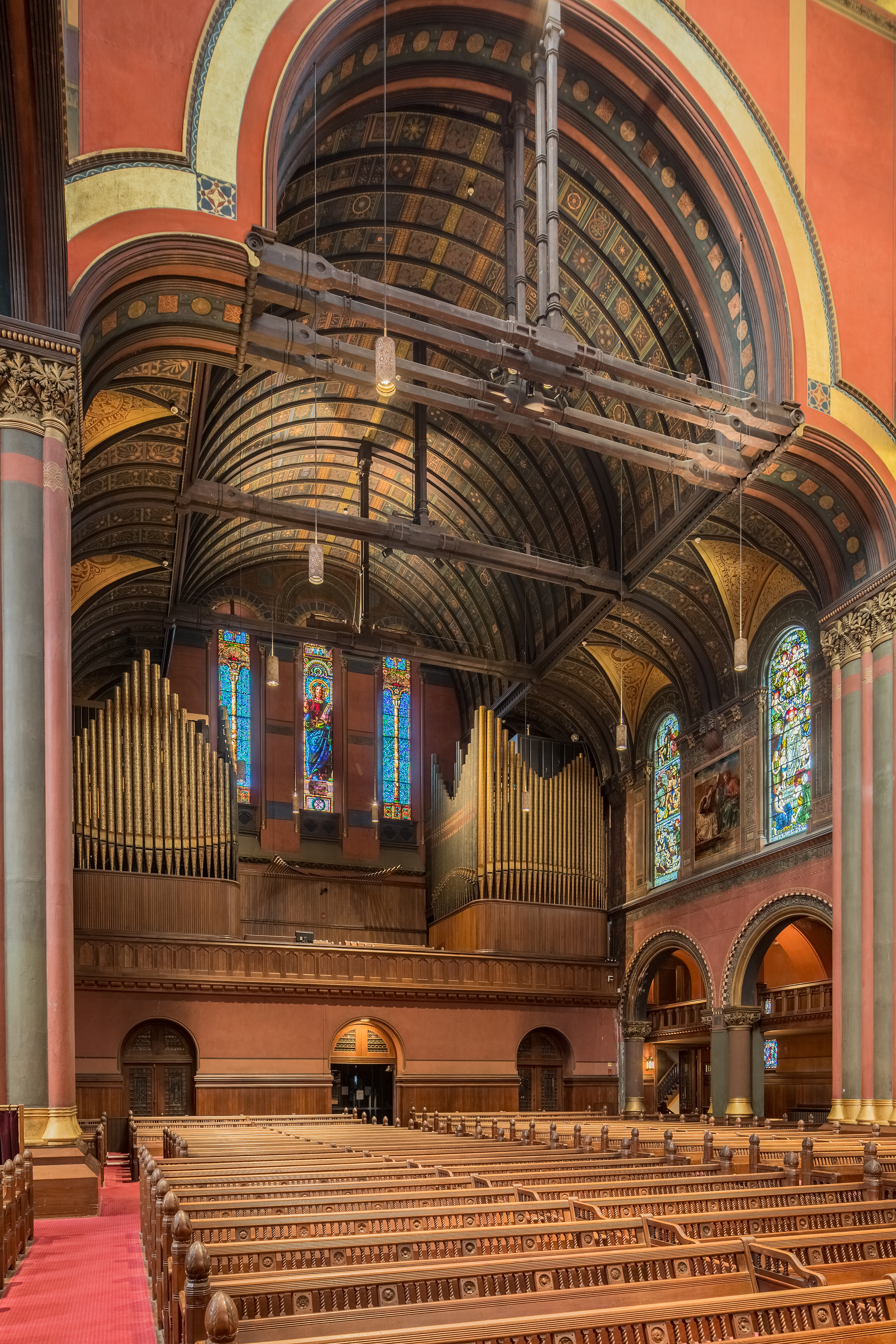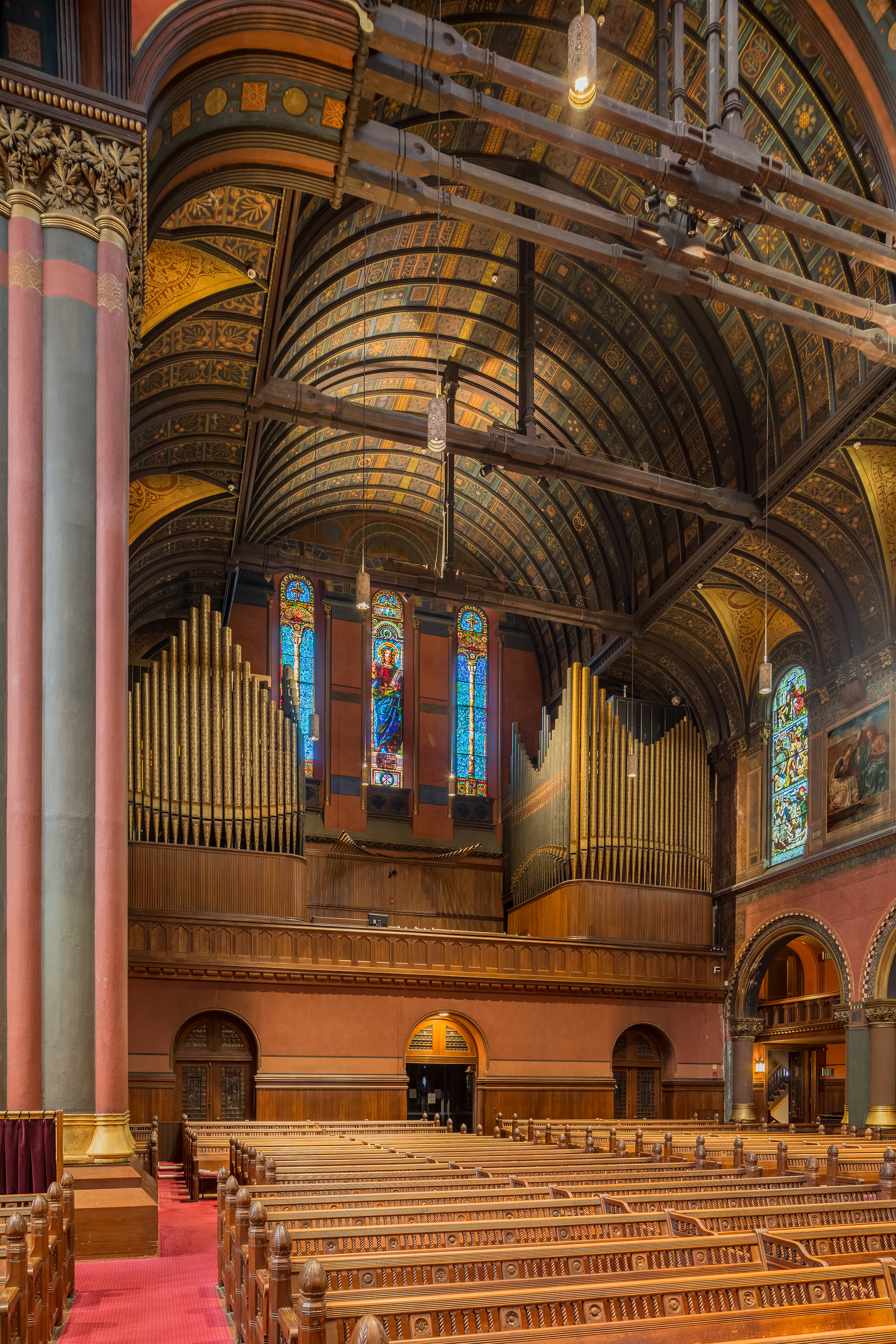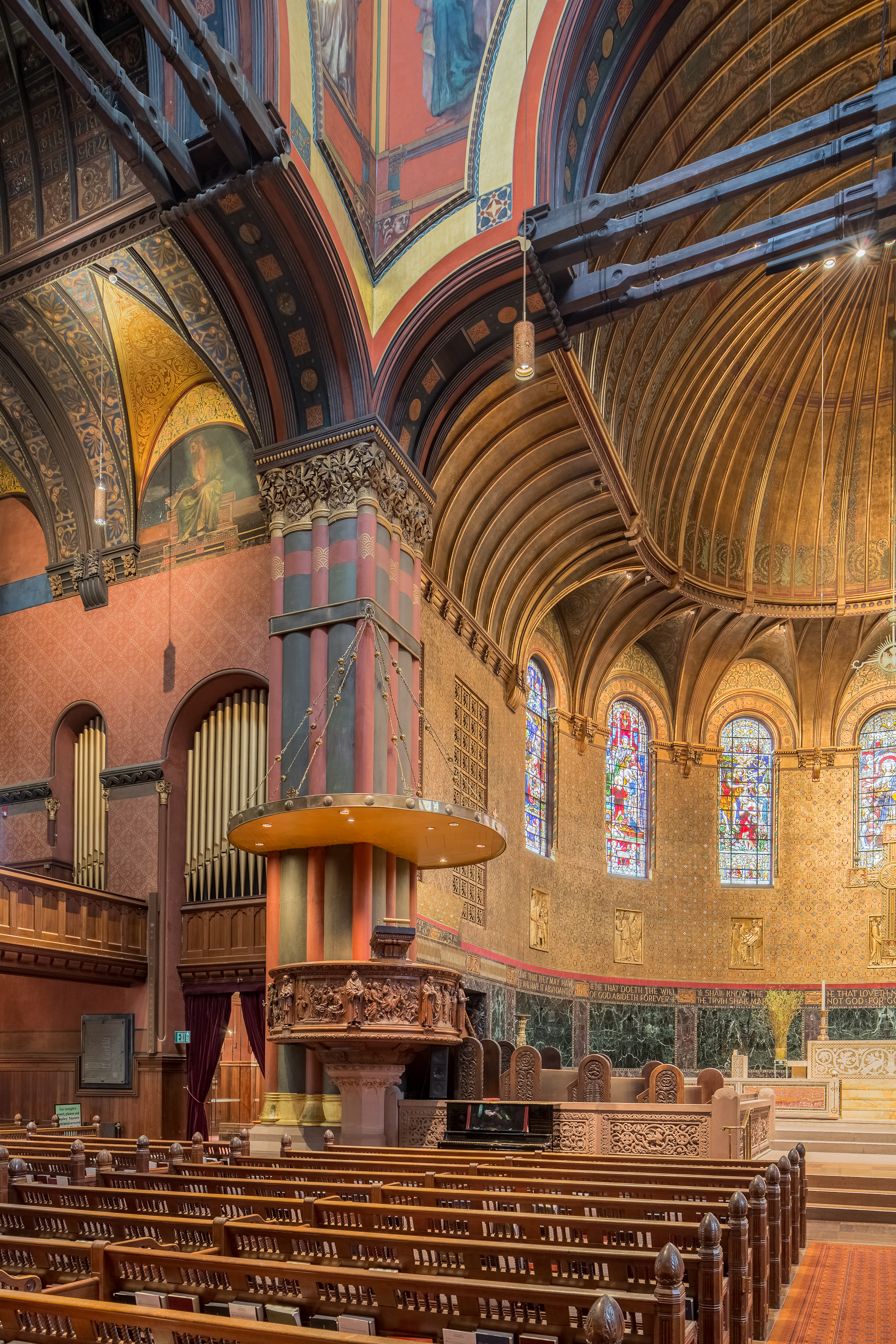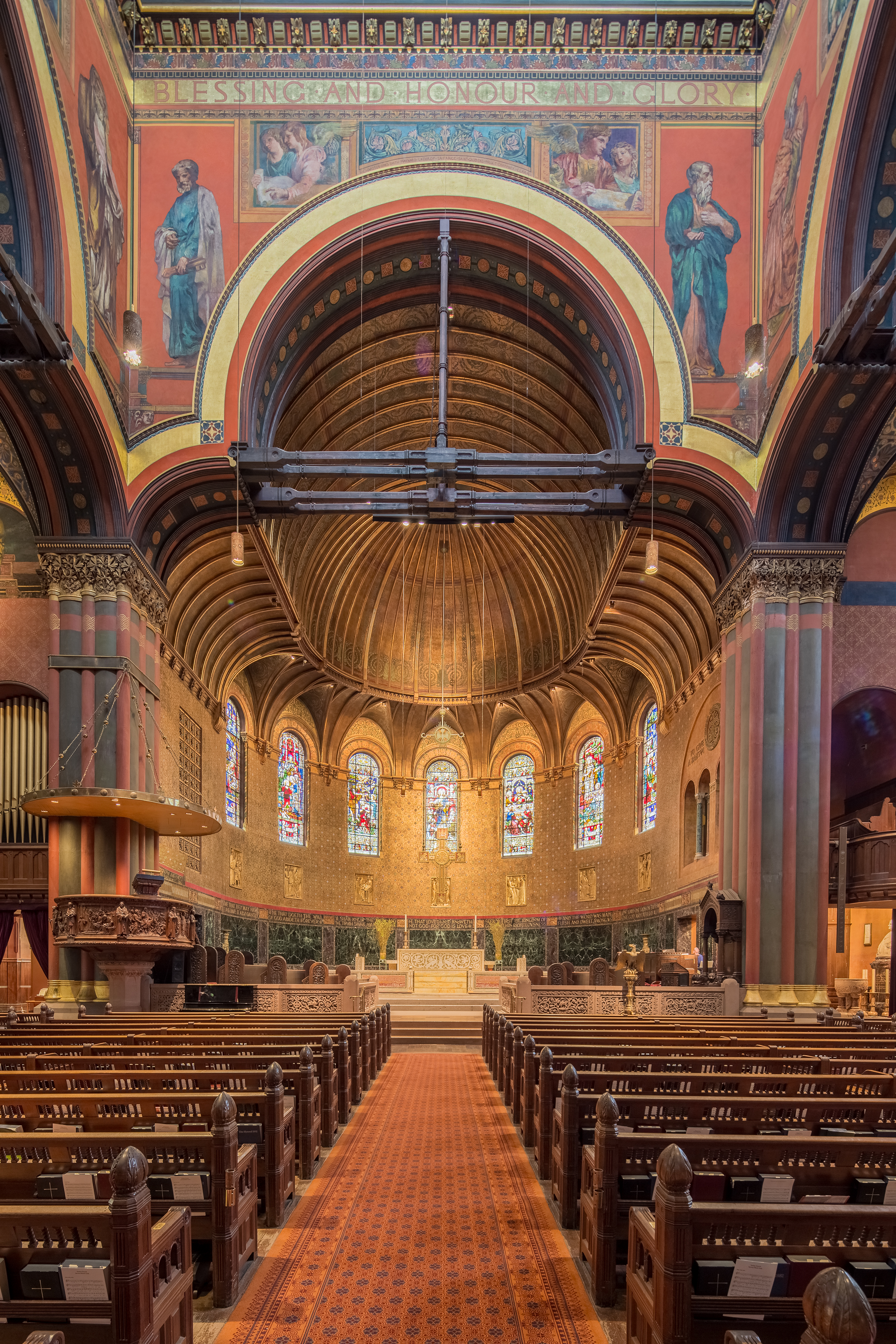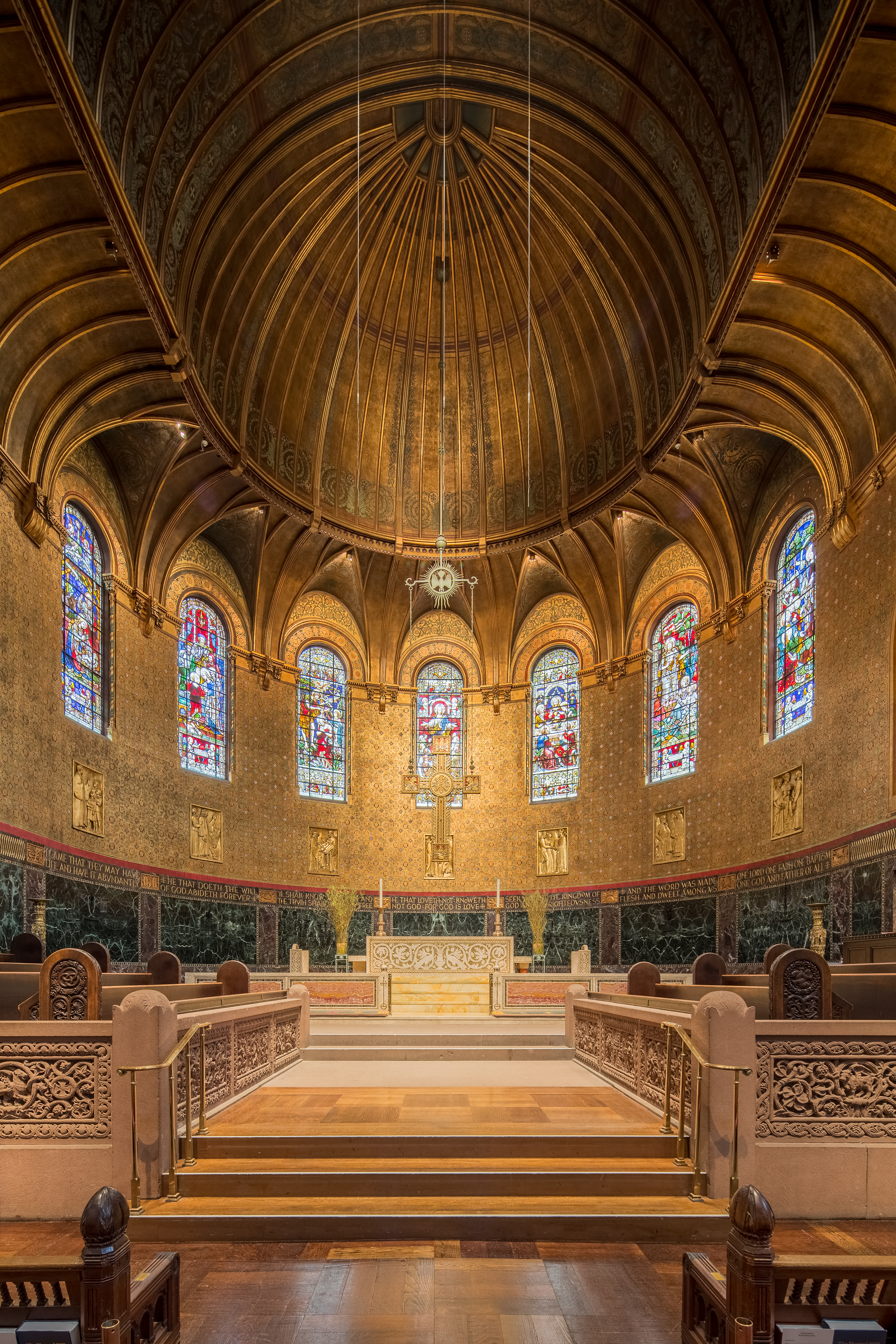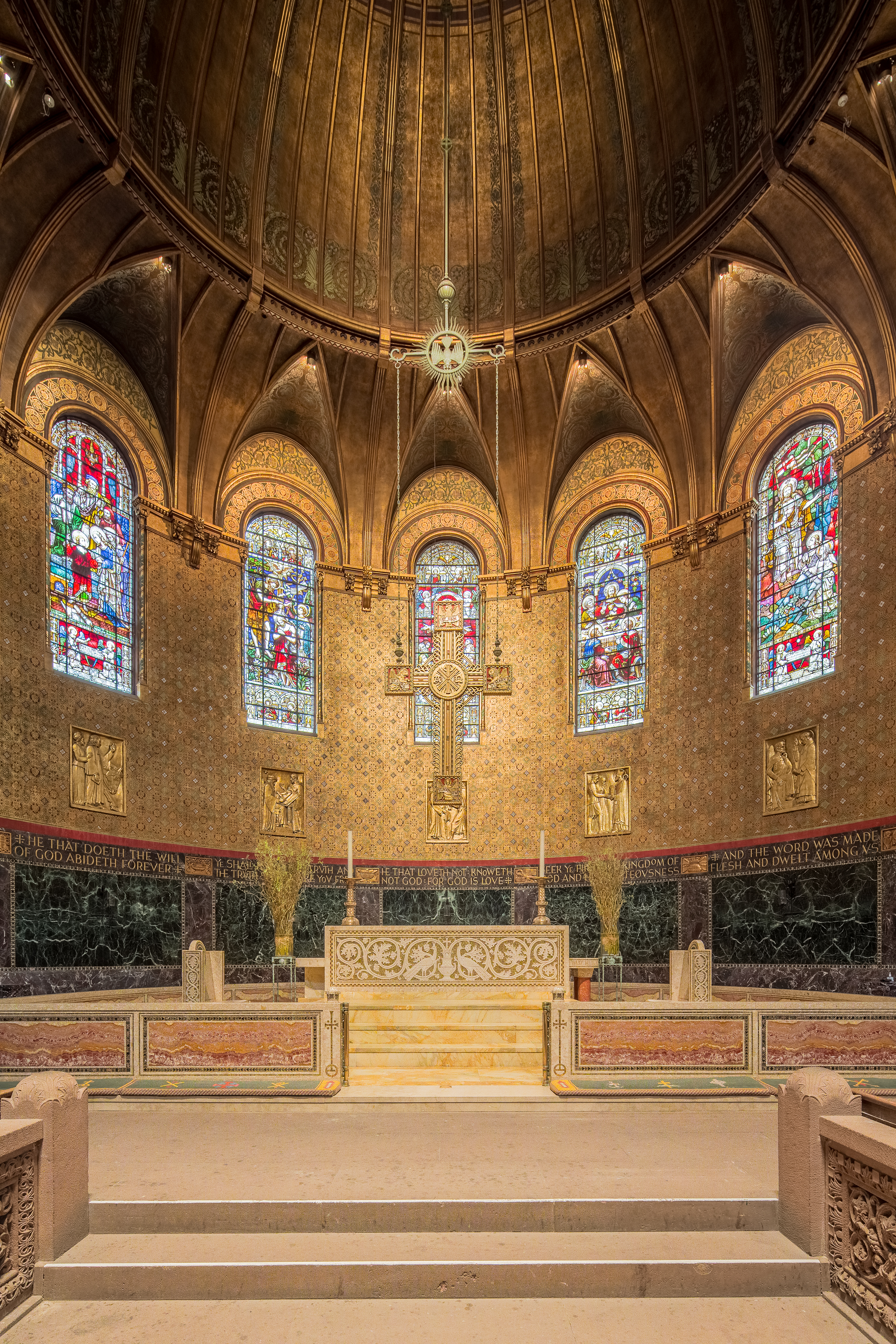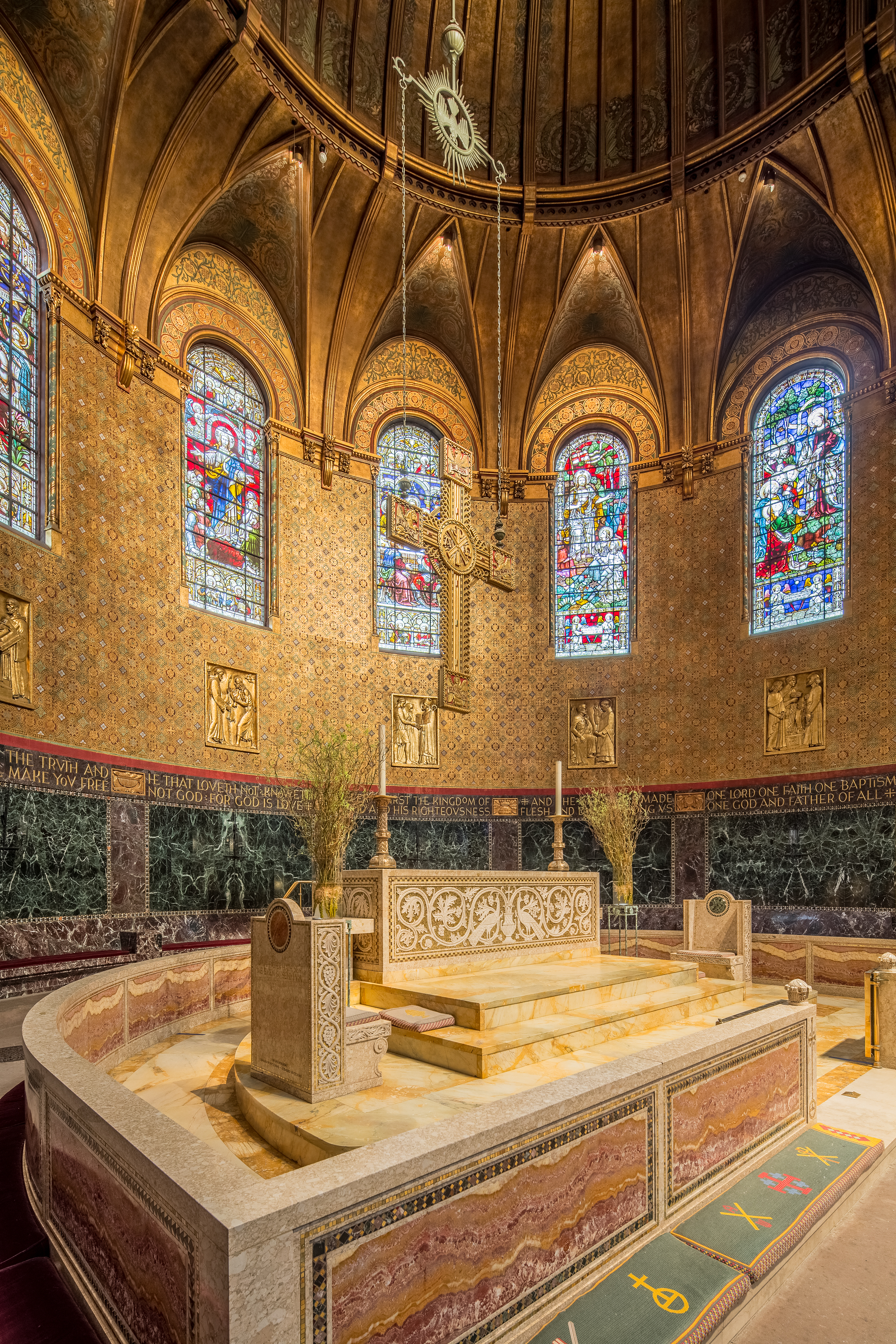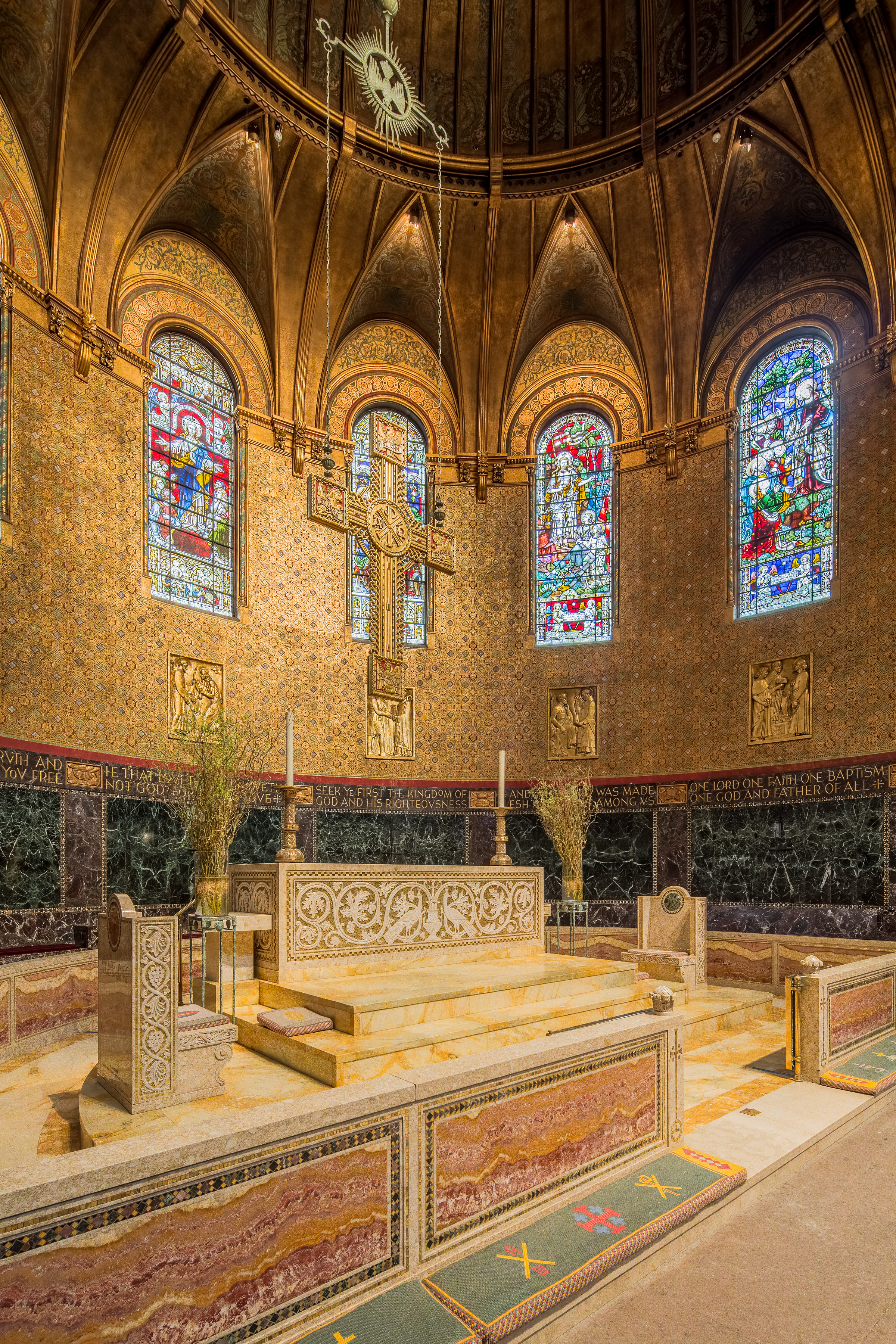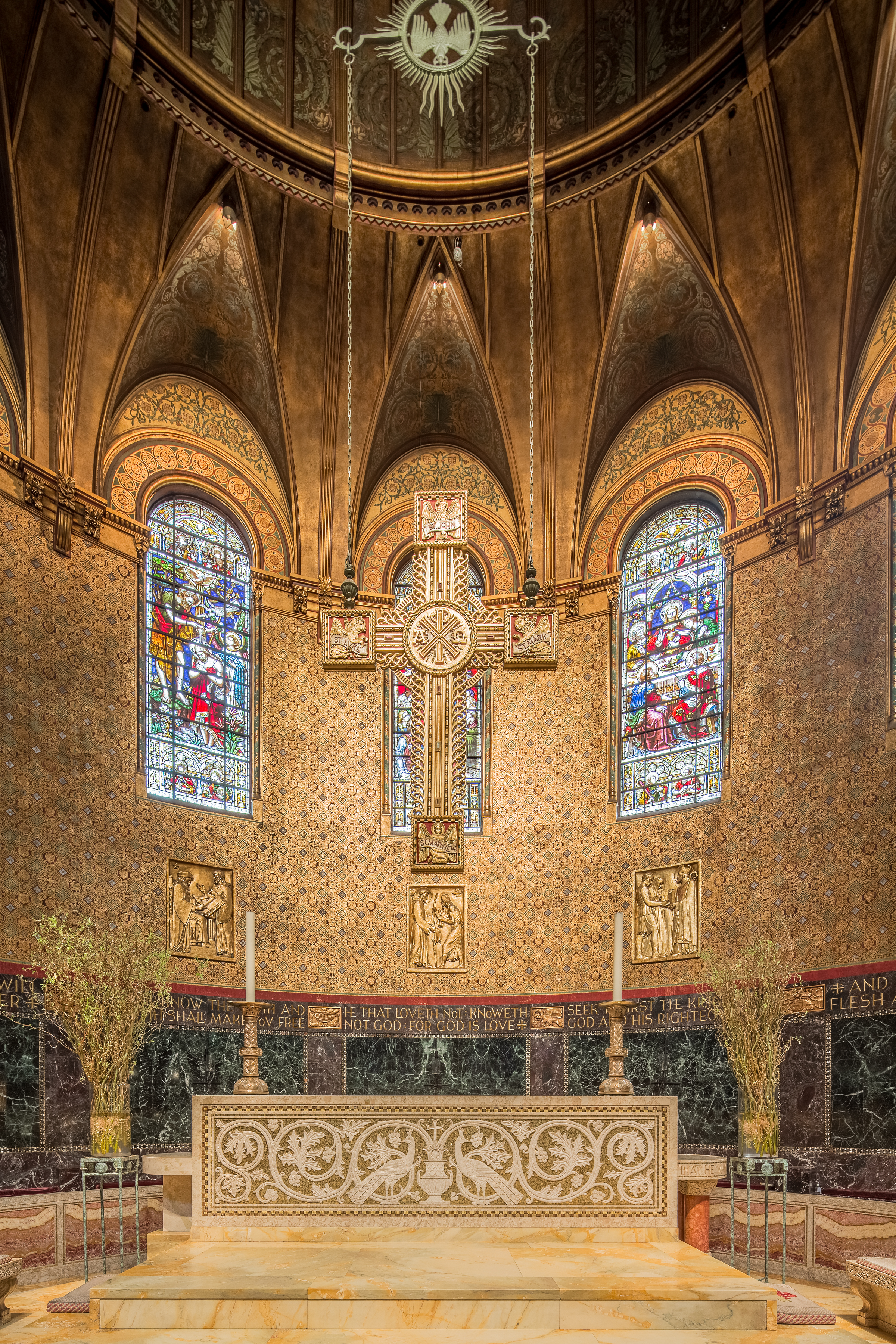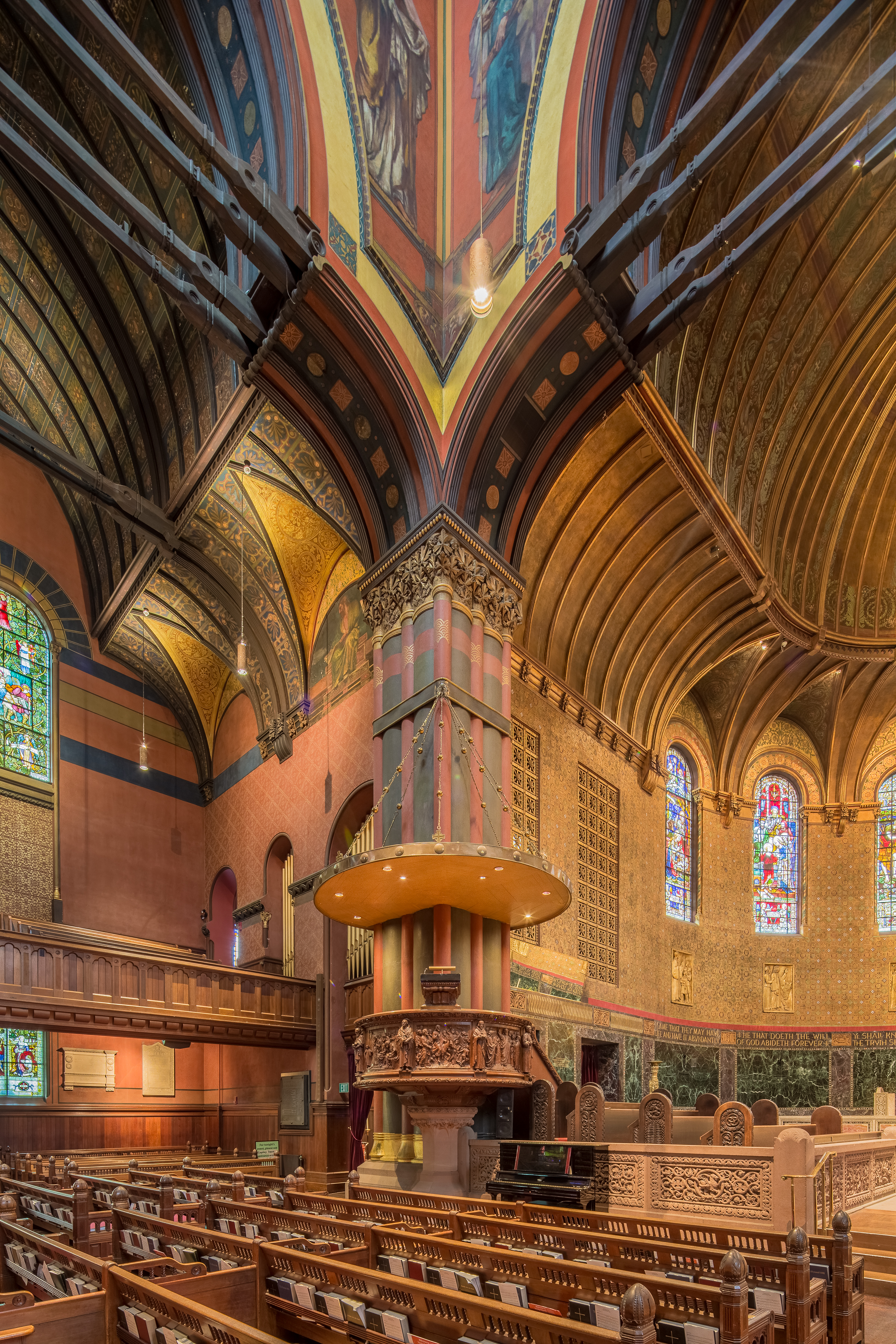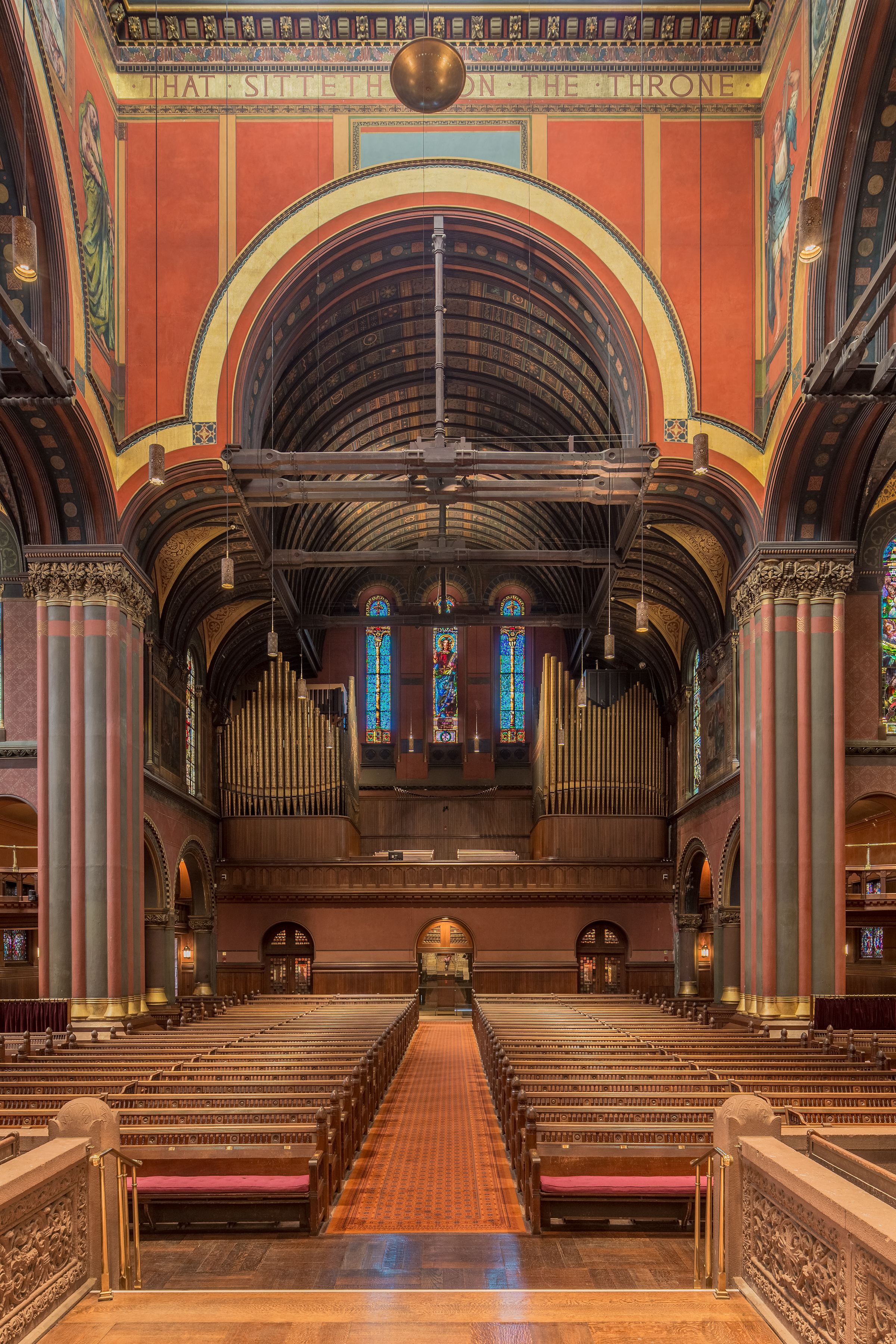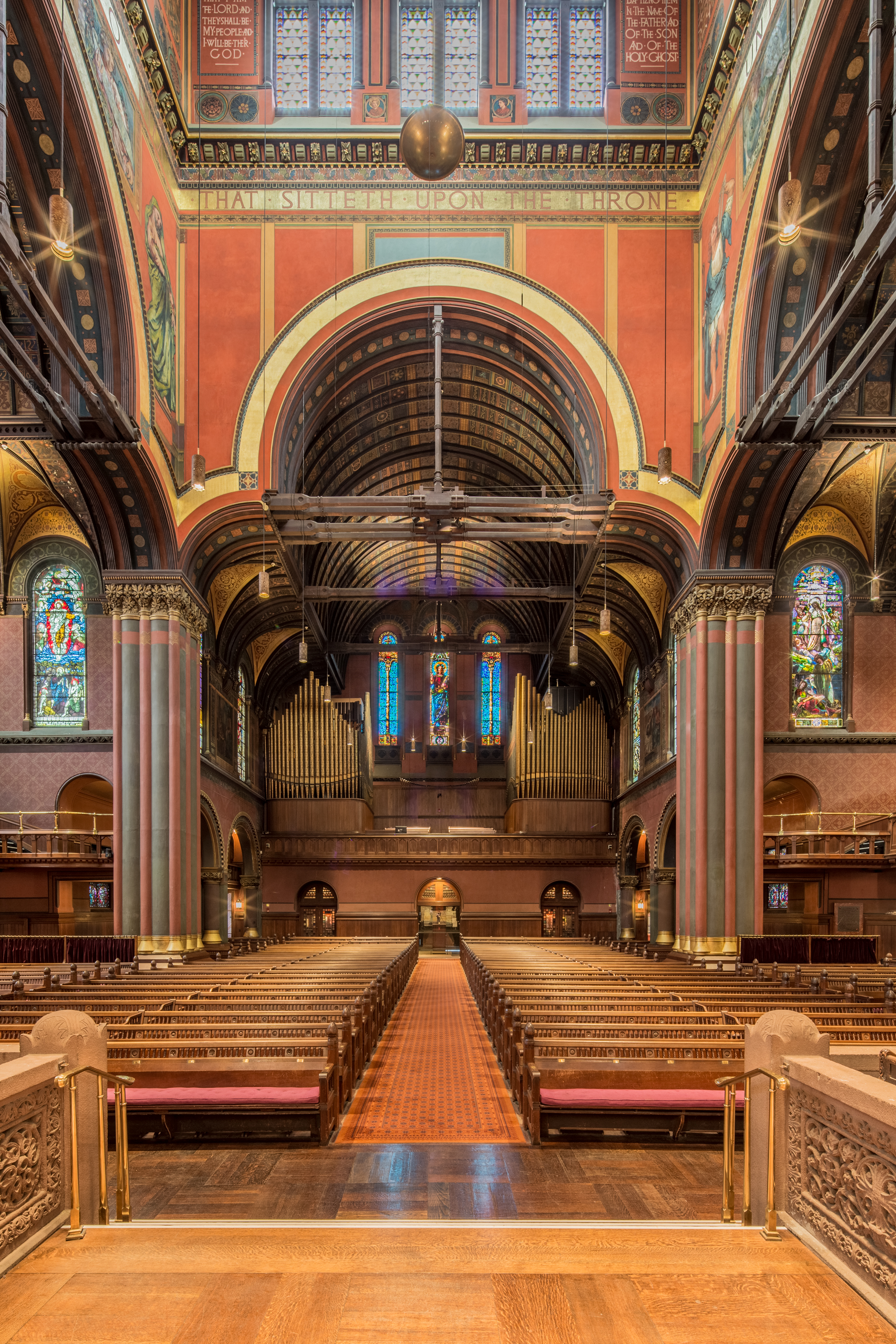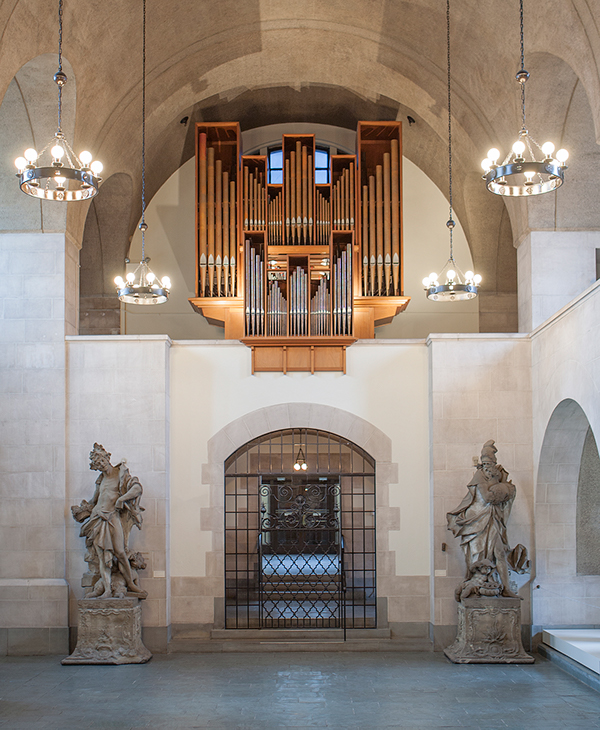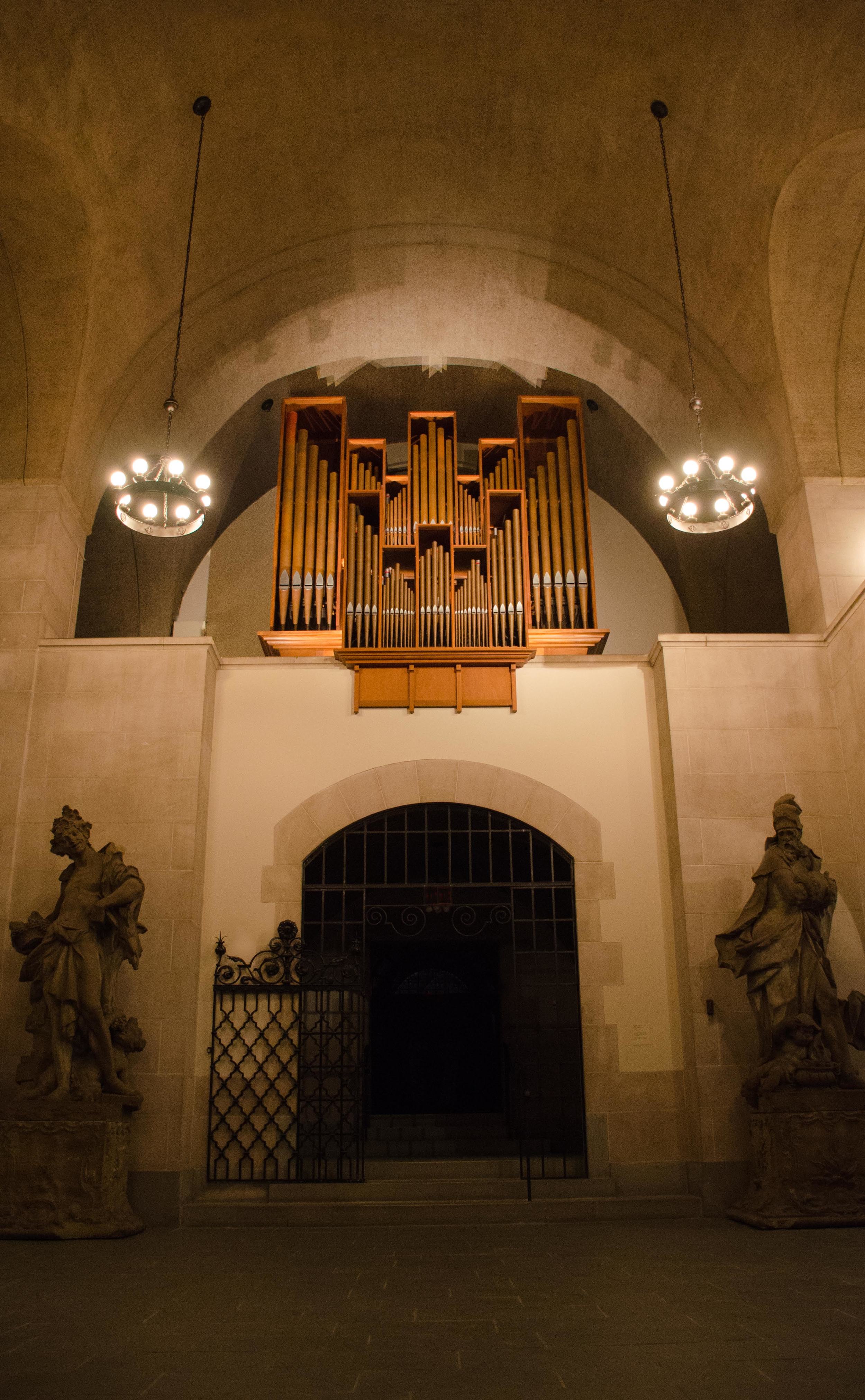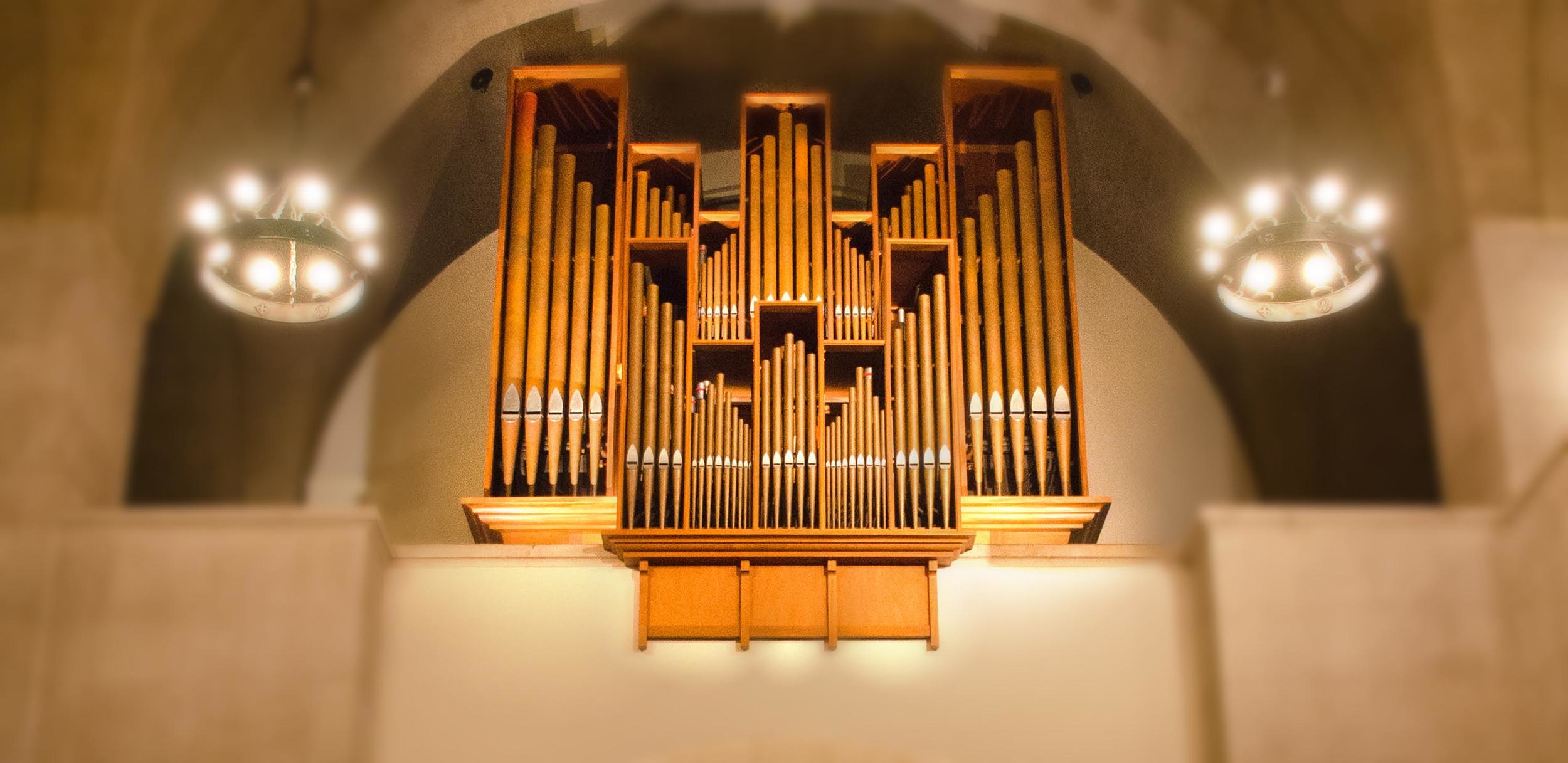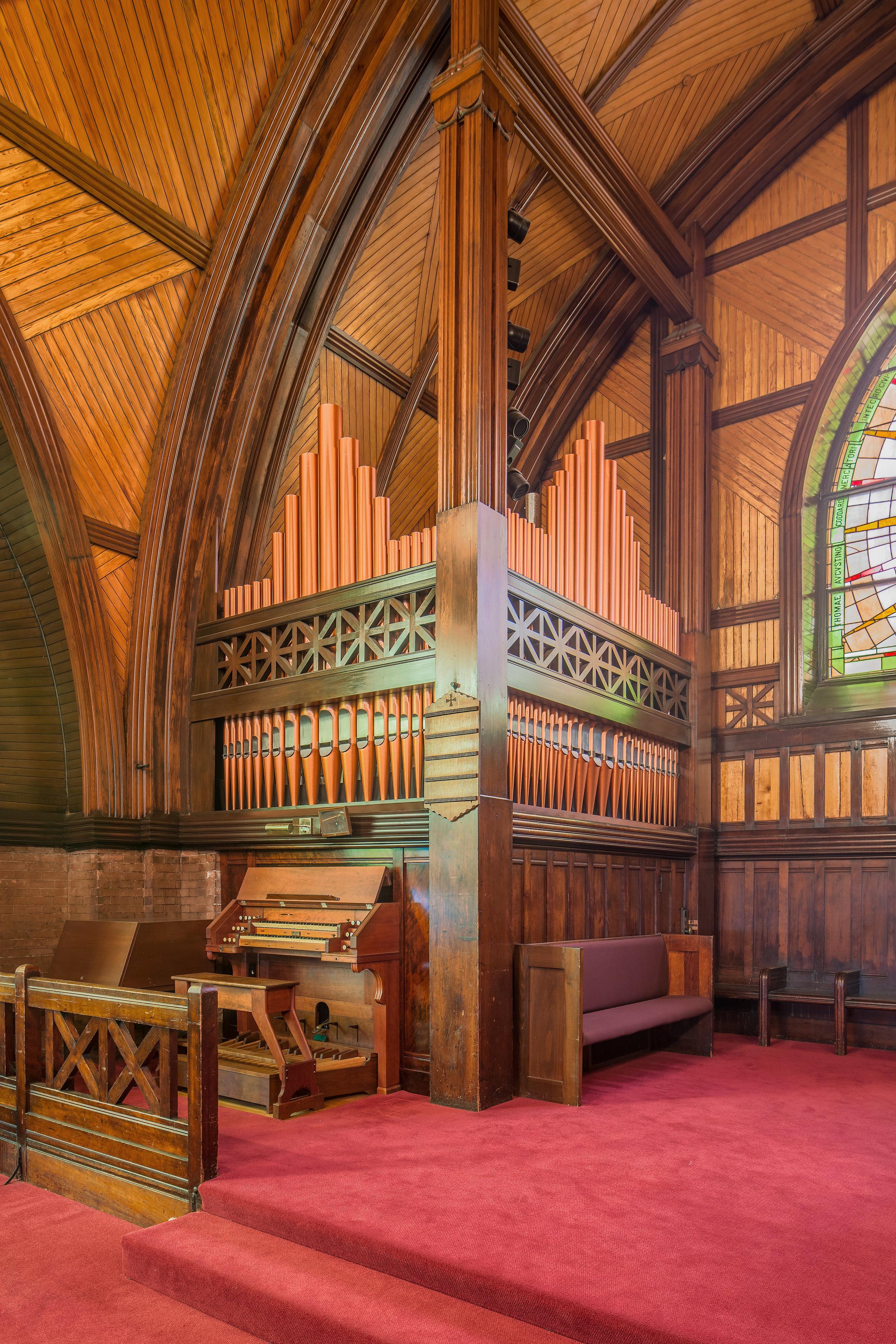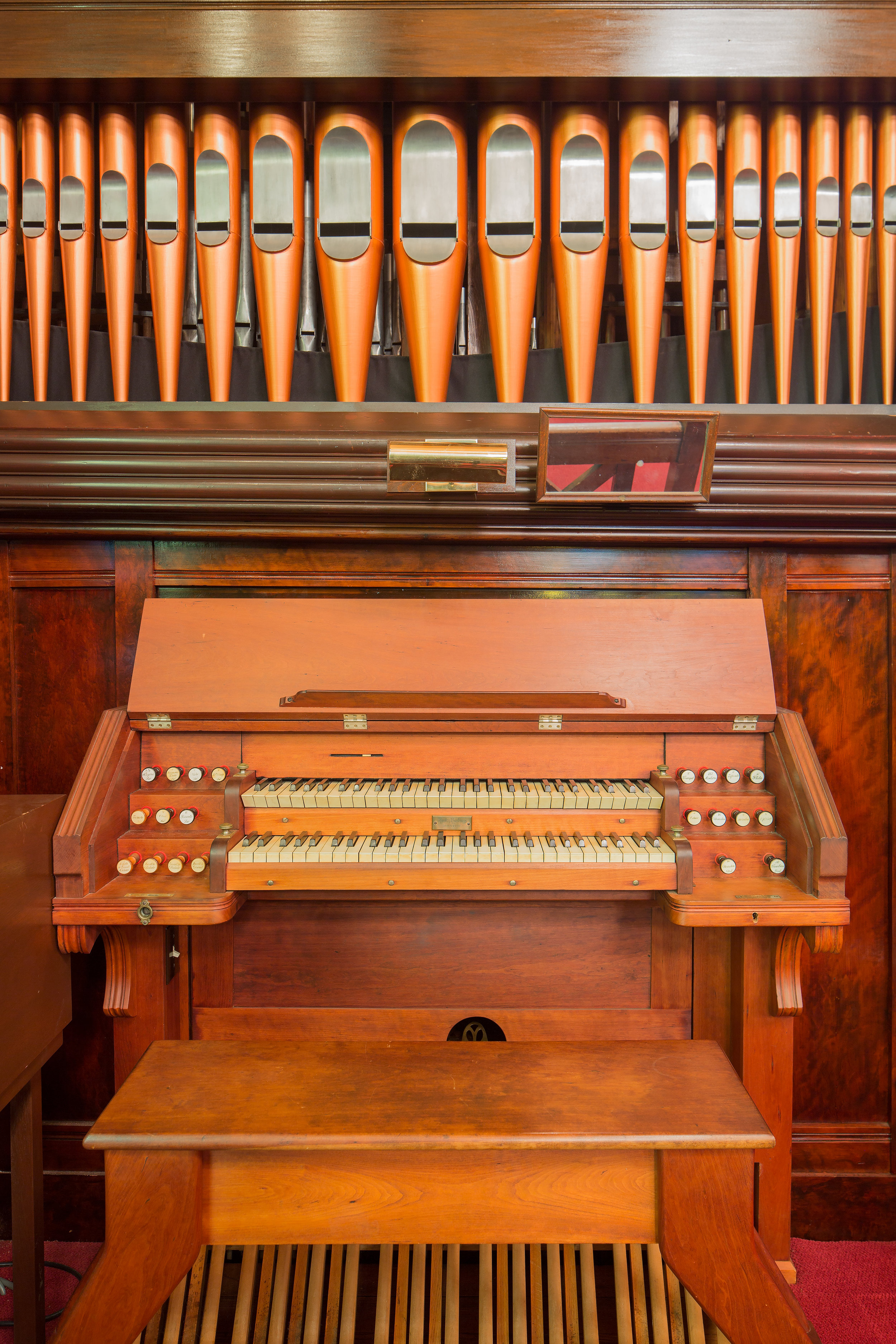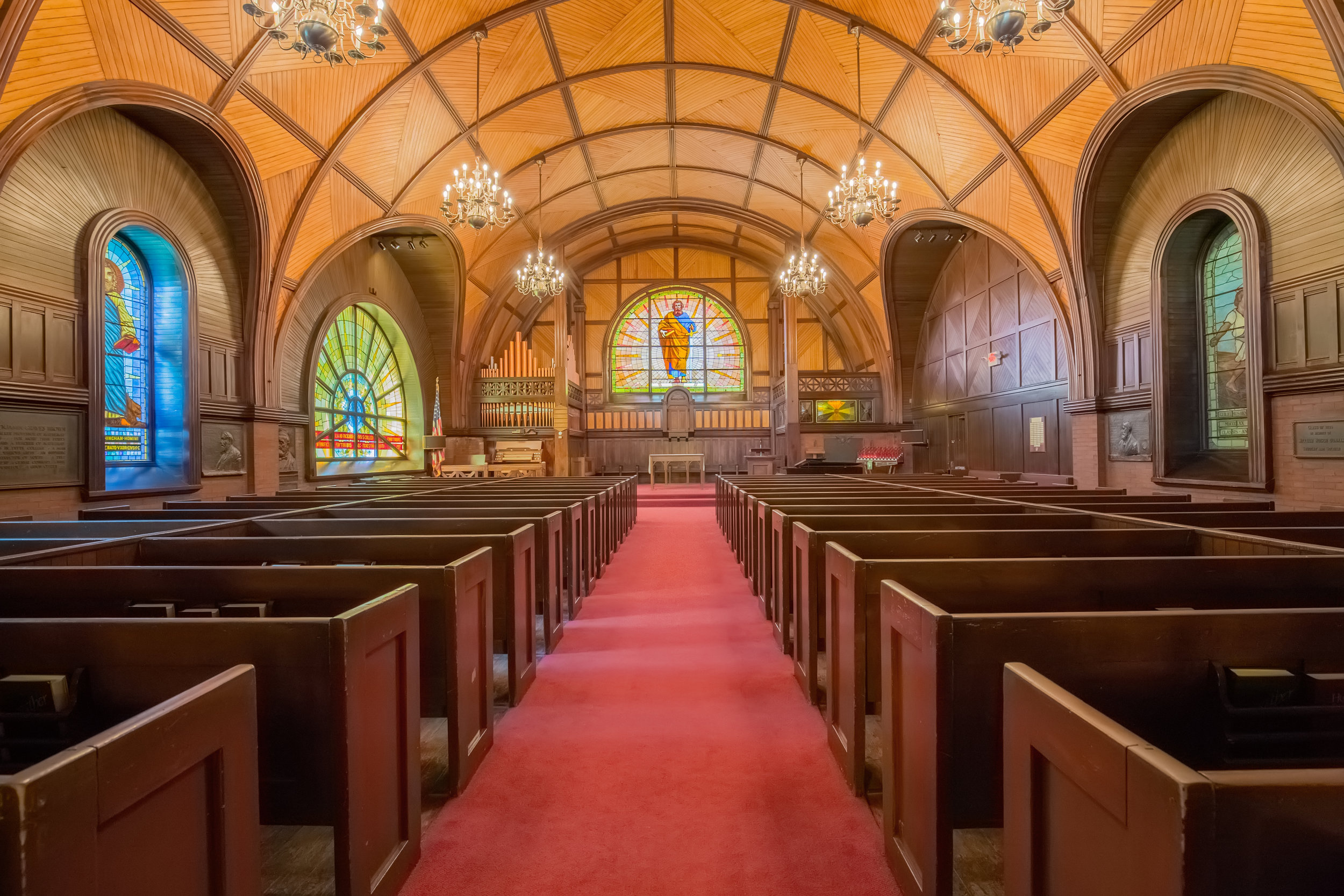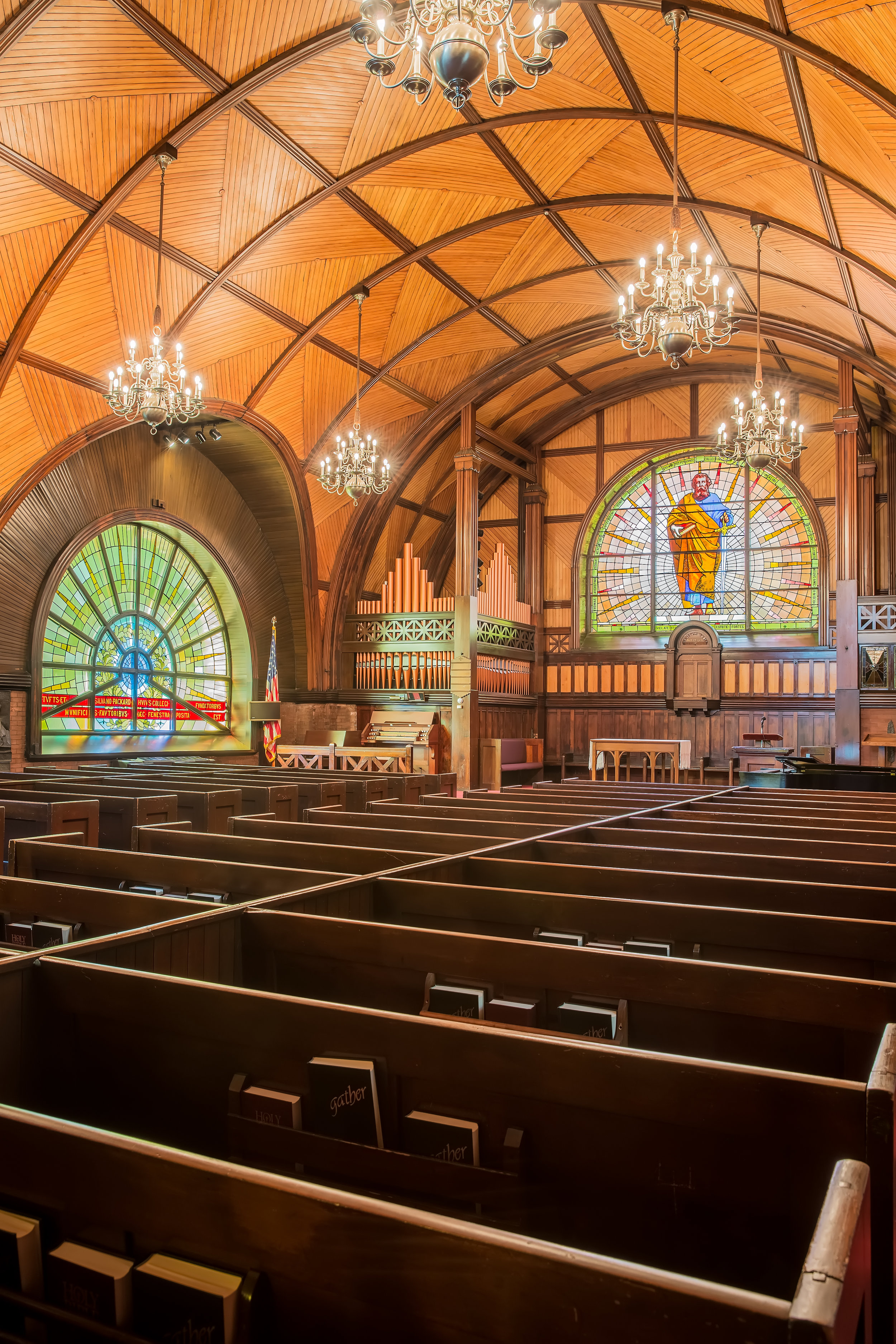The Mother Church and headquarters for Christian Science worldwide, the original Romanesque Revival building opened in 1894 on an unusual trapezoidal lot. Quickly outgrown, the adjacent Extension of 1904-1906 seats some 3,000. Architect Charles Brigham’s original Ottoman-inspired design was substantially altered by Solon Spencer Beman along classical Renaissance lines, dispensing with plans for corner towers and a minaret-cum-campanile. The result owes much to Venice’s Santa Maria della Salute. A belt of New Hampshire granite around the Extension’s base cleverly ties the two disparate buildings together. I.M. Pei & Partners with Araldo Cossutta fashioned the surrounding administrative buildings and reflecting pool in the early 1970s. The 1934 publishing house building houses the Mary Baker Eddy Library and its famous mapparium. - Ross Wood
A magnificent new Aeolian-Skinner organ in the Mother Church, the First Church of Christ, Scientist, in Boston, was placed in service for the first time June 1, with Ruth Barrett Phelps, organist of the Mother Church, at the console. This event followed a period of more than a year and a half of construction devoted to the building and installation of the colossal instrument.
The instrument includes many features the most outstanding of which is the unprecedented free use of mixtures and other compound stops. The organ contains 235 ranks of pipes, totaling 13,389 pipes and on this basis may be considered to be the largest church organ in the United States. There are 147 independent speaking stops, with twenty-two borrowed stops and three pedal extensions which makes a grand total of 172 speaking stops. Twenty-one stops, totaling about twenty-nine ranks, were retained from the old organ.
The tonal design of the organ is the work of the Boston organ architect Lawrence I. Phelps. Mr. Phelps, who also supervised the various phases of the work was employed for several years as a technician and voicer and later as a tonal finisher by Aeolian-Skinner. More recently he worked with Walter Holtkamp of Cleveland in the same capacity. For more than two and a half years Mr. Phelps has been employed by the Mother Church, devoting his entire time to directing the reconstruction of its two organs, one in the spacious extension edifice of the Mother Church and the other in the original edifice. The following information concerning the design of the new organ in the extension edifice has been provided by Mr. Phelps.
Of the seven manual divisions the swell, choir and solo are enclosed. All of the organ except the solo is installed in one large loft across the front of the auditorium. This loft is approximately seventy-five feet wide, ten feet deep and about sixty feet high. The average height of the main part of the organ is about twenty-five feet, although the facade towers about fifty feet above the floor of the organ loft. The solo is located in an especially prepared chamber, high in the northeast tower of the building, and is heard through a circular opening which pierces the center of the pendentive area to the left of and well above the main organ.
The new four-manual console has a total of 197 drawknobs and thirty-six tablets. The choir and positiv divisions play normally on the lowest manual, although the necessary couplers and separation devices are provided so that the two divisions are completely independent of each other and may be played at the same time on different manuals. The same is true of the hauptwerk and great, which normally play on the second manual. The swell and bombarde divisions play from the third and fourth manual respectively. The solo organ is a so-called “floating” division. It is available on any manual and the pedals and is the only division which operates through a key relay. Only the enclosed divisions of the organ have sub and super couplers.
The combination pistons are as follows: Hauptwerk and great, 15 pistons; swell, 10 pistons; choir and positiv, 15; pedal, 10; bombarde, 5; solo, 7; general, 10. There are also free combination pistons which are set by means of a recorder board and which do not operate the stopknobs. Normally the free combinations cut off all stops and couplers that may be drawn at the console, but a device has been provided making it possible add any drawn combination to whatever may be set on any free combination piston. The general, pedal and certain other selected pistons from the other manual divisions are duplicated by toe studs. All of the couplers to the pedal are provided with reversible pistons, as are all unison intermanual couplers.
A unique feature among the accessories is a crescendo pedal which is completely adjustable, with five separate crescendo setups available through the use of a five-button crescendo selector. All the other usual accessories are available.
The organ is designed especially to meet the unique requirements of the music of the Mother Church. These range from the accompanying of a vast audience in the singing of the hymns to the exacting requirements of radio and recording work. This results in the necessity of producing a well-ordered musical performance under radically changing acoustical conditions; also the performance of tbe great variety of music from the organ's rich heritage in a manner which may be considered to be stylistically appropriate. Even so, no attempt has been made to imitate slavishly the work of any period of organ building or of any particular organ builder.
The major flue chorus of the organ is naturally that of the great. Basically the chorus consists of the 8-ft. principal, 4ft. prestant and the full mixture, these being topped by the scharf. All of these pipes are equipped with mouths which have a width equivalent to a full two-seventh of the circumference of the pipe. Inasmuch as the use of two-seventh mouthed principals has seldom enjoyed unquestionable success in this country, it was decided to adopt the very ancient and time-honored device known as a keychamber, which has always accompanied the two-seventh mouth in its most successful applications, to the modern windchest. Thus each pipe of the 8-ft. and 4-ft. stop was provided with individual key chambers (perhaps in this application more correctly called expansion chambers). Later it was proved necessary to apply the same principle to several stops in the hauptwerk, where, although the principal chorus is equipped with one-fourth mouths, expansion chambers were found necessary in order to produce a quick response, while retaining a certain ease of speech typical of the best low-pressure work.
To make possible the best results from the extensive array of compound stops, G. Donald Harrison, president of the Aeolian-Skinner Company, whose cooperation has been a vital factor contributing to the overwhelming success of this entire project, worked out a system together with the designer of applying large key chambers to the regular Aeolian-Skinner windchest. This makes it possible for all the pipes comprising one note in a compound stop to stand on a common channel, thus receiving their wind from a common source. This also provided a much larger channel for this purpose than is usually available on the modern pitman chest. This system for accommodating compound stops was used in one form or another for all twenty-six of the harmonic corroborating compound stops. Because of this it has been possible to finish these stops in such a way that they evidence a singing quality and a blending ability not always found today.
The hauptwerk is a moderately scaled very lightly voiced division standing in the center and at the top of the main structure immediately under the wheel window. Emphasis has been placed on incisive, clear speech and marked contrast in color rather than on power or great variation in strength between the stops. Because of this and its favorable location this division exerts a strong influence even when used against or together with the full great. The sesquialtera is composed of softly-voiced, small-scale principal pipes. The scale of the rankett was especially developed; the sound is rather distantly related to that of the vox humana. The trompette is of a scale developed by Mr. Harrison about two years ago using small English shallots; the tone is free and not the least aggressive.
The great is located on the same level as the hauptwerk and to the left. It is a strong full-bodied division containing the strongest flue work of the entire organ. As mentioned above, the principals are equipped with two-seventh mouths. The scaling is large. The pipes are generously winded. The two 16-ft. mutations are fluty and soft. The 32-ft. quintade is a larger scale than the 16-ft. quintadena on the hauptwerk, but it fills a similar office for the graver great. It is a thoroughly usable stop adding gravity without thickness. The two rehabilitated open flutes are typical of the best examples of their species. The scharf is the crowning glory not only of the great but of the whole organ. The cornet is really a complete secondary principal chorus about the same scale as the principals but with one-fourth mouths.
The enclosure for the swell is centrally located in the organ loft. It occupies a floor space approximately twenty feet by six feet eight inches and rises against the rear wall to a height of about twenty-two feet. Actually the hauptwerk windchests form the top of the swell-box. The full swell is about equal in strength to the great, though of course there is a sharp contrast in color. The sesquialtera is voiced equal to the diapason in strength as are the plein jeu and cymbale. The three-rank fourniture is a small, moderately voiced mixture. The chorus reeds are of the French type, which have become virtually a Harrison trademark, although several alterations in scaling have been made to adapt them to the acoustics of the auditorium.
The choir is all on one level and stands immediately to the right of the swell. It is a gentle division whose chief purpose is to assist the softer work in the swell in accompanying the soloist. The Mother Church uses only a soloist. As it was necessary to “double deck” the swell, it is fairly certain that with changes in temperature the pitch in the upper and lower swell might not always be together. To reduce the significance of this fact all the chorus work in the swell, both flues and reeds, was placed on the upper level while all of the softer work was grouped on the lower level. This means that the accompanimental stops of the swell will always be in tune with the choir and that the stops that make up the swell choruses will always be in tune with each other.
Returning to the choir, the sesquialtera consists of two large-scale soft open flutes. The carillon is composed of a large-scale rohrflöte and two nachthorns. The 16-ft. bassoon is half-length. The tuba is the genuine article and is enclosed.
The positiv stands on two levels directly in front of the swell. The specially-constructed lower windchest projects in front of the small center limestone arch approximately two feet and a beautifully carved mahogany case has been provided which covers the front of the chest. This casework is not merely decorative, as it provides a home for the lower pipes of the 8-ft. viola da gamba and 4-ft. prinzipal, these being of polished tin. So carefully were these details worked out that many of the smaller front pipes which appear to be standing on the mahogany case are actually standing on the main windchest. The whole division is voiced lightly. The mouths are cut very low and nicking is kept to a minimum. The gedeckt is the only new manual wood stop made for the organ. The cornet is wide scale and lightly winded. It is placed together with the three reeds on the upper chest. This upper chest protrudes beyond the small limestone arch only a few inches and the first rank of the cornet, which is of polished tin, is visible in the background above the main positiv case. The three reeds have been developed especially for this organ and are refined examples of their European counterparts.
The bombarde organ is placed on the same level as the great and the hauptwerk and this completes an array of unenclosed pipework across the top of the structure of the organ. The main portion of this division stands in the right end of the loft over the choir, but the two-rank principal is part of the facade. It has been arranged to frame the wheel window as it stands on the cornice of the limestone arch with the first rank, of polished tin in front. The cornet is identical with the one in the positiv except that it is stronger in every way. The two mixtures and the harmonics are voiced to complement the reeds, although together with the principal they are very useful in accompanying the enormous congregation. This is the reason that the bombarde was placed at the opposite end of the chamber from the great. The reeds are harmonic, with French shallots, and are voiced normally for the wind pressure.
The solo is in a newly-constructed chamber which replaced the one formerly occupied by the old echo organ. Several of the echo stops were retained. The old great principal chorus was revoiced and placed in this division with the two old solo flutes. The celestes, however are all new. The dolcans are ten semitones larger at the top than at the mouth. The division is actually an amazingly useful echo-solo-string-antiphonal organ.
The pedal organ was planned with the idea of making the use of pedal couplers unnecessary. Certain of the softest manual stops were selected for borrowing to the pedal. This gives a considerable choice of soft pedal tone, ranging from 32-ft. to 4-ft. without the customary disadvantages brought about by the use of manual to pedal couplers and, as these stops are seldom used in manual combinations until the tonal level has passed beyond the point where they would be of any use in the pedal, there is no real loss of independence. The twenty-nine independent pedal stops are voiced to develop the individual character of the pedal, so that by contrast in color as well as in pitch the pedal line is always clearly distinguishable from what is being played on the manuals. All of the pipes of the violon and grossquinte and twelve pipes of the 16-ft. principal are in the facade. The pipes of all stops 8-ft. and smaller are placed on five chests which partly form the top of the-choir box and this close grouping of the pedal upper work has made a considerable contribution toward the development of the individuality of the pedal. None of the pedal reeds are overly assertive, but when properly drawn fit neatly into the pedal ensemble.
The design of the imposing new facade is the result of many weeks of close collaboration between the organ architect and William G. Perry of the Boston architectural firm of Perry, Shaw & Hepburn, Kehoe and Dean, which was the architectural consultant for an extensive program of renovation in which the Mother Church has been engaged. Certain limestone and plaster features which were part of the old front were retained and incorporated into the new design. Most of the old front pipes also were retained and were redecorated. About 300 new pipes were added to the display and there are now 377 polished tin and gold-leafed pipes visible across the front of the organ. The majority of these are speaking pipes.
Photo by Len Levasseur



